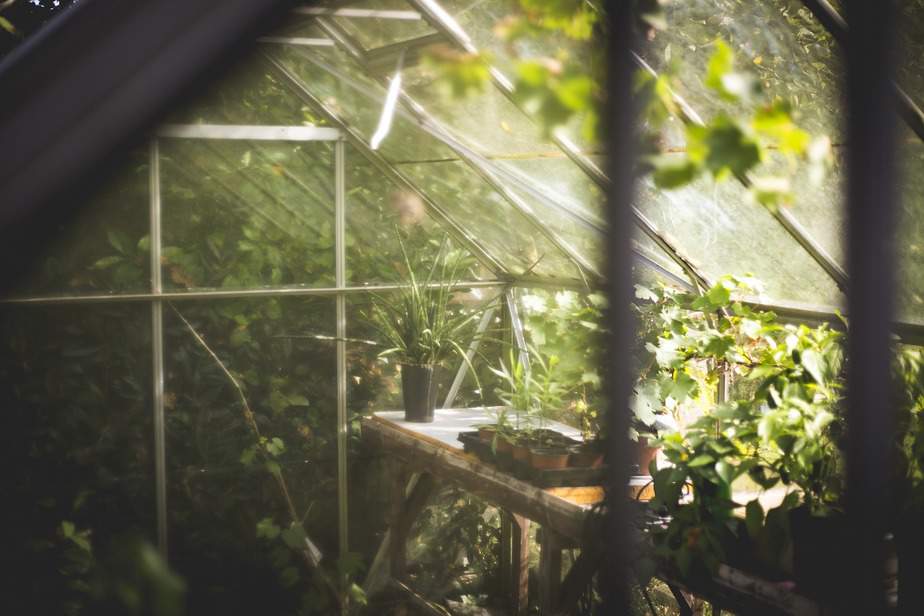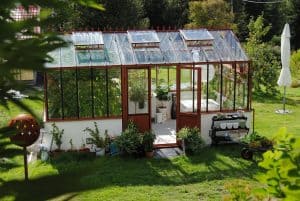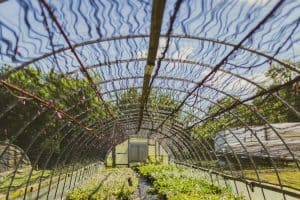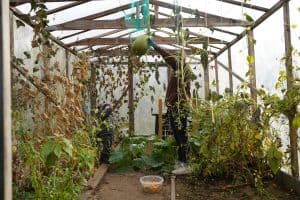A greenhouse misting system does to your plants what one of those cheap handheld automated misting fans does for you. You know how good those feel when it’s toasty outside, right?

Well, in this guide we’ll briefly go over greenhouse misting systems so that your plants can get some satisfaction in the suffering heat.
What Is a Greenhouse Mister?

I grew up in a college town in Pennsylvania that hosts one of the biggest annual summer art festivals in the country. In July in Central P.A., it gets surprisingly hot. On one downtown street, playful installations used water to engage festival-goers and help us cool off.
Kids preferred the bucket-dumping maze, but adults who didn’t want to get drenched preferred strolling through the gardened trellis that let off clouds of mist. That refreshing mist felt like it had been in a water cooler, but it was science (!) that made it seem chilled.
Have you been to an amusement park, state fair, or even an outdoor festival that uses a water mister to help attendees cool off? Then you know what I’m talking about!
And you also know the essential operations of a greenhouse misting system. Wow, you learn fast!
Greenhouse misting systems use evaporative cooling to keep your greenhouse temperature perfect for growing plants. Water is sprayed through pressure-increasing, minuscule nozzles, filling the air with a super-fine mist. As that mist evaporates, heat from the air is “consumed” (woo, chemistry!), creating a cooler environment inside the greenhouse.
As you might expect, greenhouse misters also increase the relative humidity of a space.
Greenhouse misters are great for:
- Starting seeds and cuttings
- Maintaining proper relative humidity
- Cooling greenhouse air during hot seasons
- Nurturing exotic or sensitive plants
- Cooling off on a hot summer’s day!
You can either buy a ready-to-install misting system kit (which is really just a fancy hose with connectors and nozzles) or build your own from scratch.
A Note on Misting Fans in your Greenhouse
Misting fans are not to be confused with misting systems. They’re not interchangeable, although they are both useful.
A misting fan will add air circulation as well as air cooling to the mix. While spreading air with powerful fan blades, a misting fan expels fine water mist to activate evaporative cooling.
A bonus of misting fans is that they can typically be set to operate fan-only, mist only, or as a mist-plus-fan!
But you should have already set up an efficient fan and vent system in your greenhouse, so as to not need a misting fan. If you’re still learning about greenhouse airflow, check out our full article exploring Greenhouse Cooling and Ventilation. Learn more about fans with our Greenhouse Fans Guide.
Components of a Misting System
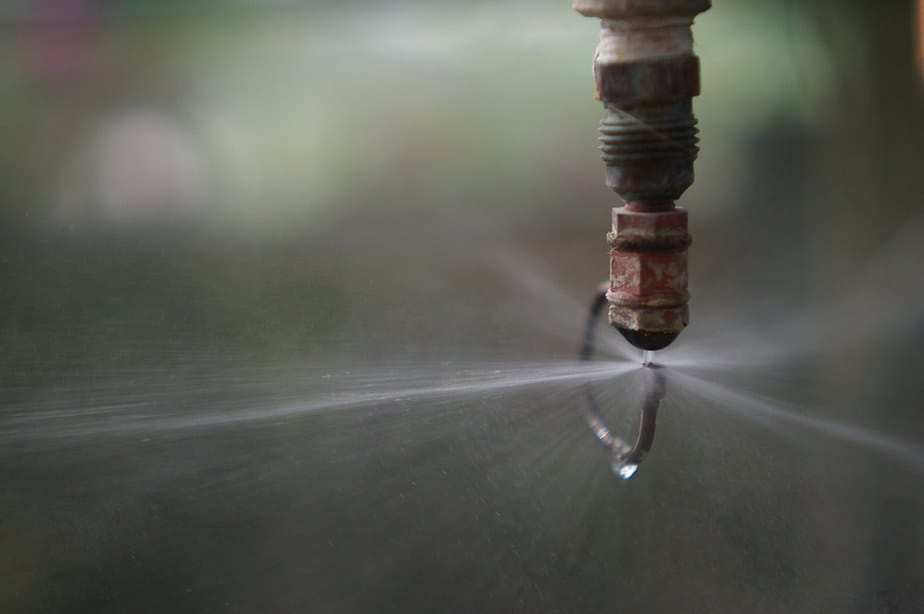
If you’re going to mist your greenhouse correctly, you’ll need a few different inexpensive pieces of equipment to get the job done.
Nozzle
A durable, fail-safe nozzle is an indispensable part of an effective mist system. You don’t want nozzles leaking and dripping onto your plants and the greenhouse floor.
Going with a good-quality, rust-resistant brass and/or stainless steel nozzle will save you tons of frustration and repair/replacement money in the long run. Plastic nozzles are cheaper, but metal is a much more prudent choice.
When buying nozzles for a DIY misting system, be sure to check that the threading on the nozzle matches the threading size on your compression fittings (the piece that connects the hose to the nozzle).
Compression Fittings
Compression fittings are sturdier pieces that connect your water-brining hose to water-misting nozzles. They come as T, elbow, and other shapes, to fit your needs.
The compression fittings directly connect your nozzles and your irrigation tubing, so check and double-check that the tube diameter and threading sizes match before you purchase these parts!
Tube or Hose
The water-carrying tube is the most easy-to-use and economical part of the mister system. Choose a ¼-inch or ½-inch delivery tube depending on your needs and the size of your compression fittings.
Filter
If you’re reading this: attaching a mesh filter to the spigot that feeds your mister system is mandatory! The price (in aggravation) of a clogged mister nozzle is much, much higher than the $10 it costs to get a simple filter.
How To Use a Greenhouse Misting System

Ventilation First!
It’s essential that you already have a proper circulation/ventilation set-up in your greenhouse. Without sufficient circulation, a misting system won’t work.
While a misting system will enhance ventilation, by encouraging air to move around as temperatures vary and preventing air stratification and shading, a mister does not replace vents and fans.
Watch Your Water
Misting nozzles vary according to the volume of water they spray. Many nozzles are adjustable. Think about a garden hose nozzle: you can tighten or loosen it to change how much water comes out. The tighter the nozzle, the more “misty” the water, and the less volume of water being released.
You can guess that less water per hour will make things less…well, wet. So if you are aiming to simply cool your greenhouse, tighten the mister nozzles or purchase a kit with smaller nozzles. (Mist at about one gallon per hour, if you’re measuring with a water meter.) For keeping sprouting seed moist, mist more. (Closer to three gallons per hour.)
If you don’t have a water meter, the best way to find the ideal water misting volume for your greenhouse is the most reliable age-old farming trick: observation. Play around, experiment, observe (plant health and soil moisture), and measure (temperature and air humidity) to find what works best.
Remember that your greenhouse garden will need varying degrees of misting throughout the changing seasons, as well as throughout each plant’s lifecycle!
How to Install a Greenhouse Misting System
Choosing a Kit
If purchasing a ready-to-install mister kit, all you really need to choose is the hose length.
Installation of a kit is pretty darn self-explanatory, although you may need to purchase an adapter for your spigot.
If you liked playing with K’Nex as a kid, you can build a greenhouse misting system from a kit.
Placement: The High Point
Misting placement differs for general greenhouse climate control and baby plant propagation.
For maintaining overall greenhouse temps and humidity, you should install a misting system at the highest point in the house.
For starting seeds or cutting, place your misting system directly above the flats or containers. Position them at least 2-3 feet above the plants—you don’t want the mist drenching the soil. This will likely mean you need to build a mounting structure on which to position the misting system (since the roof frame beams of the house will be much too high).
Can I Build My Own Greenhouse Mister System?
You betcha! Like many aspects of building a greenhouse (or building anything, really), it is certainly more challenging and time-consuming to build your own mister system, but it might be one of the “easier” DIY greenhouse projects.
As I mentioned above, the most important part of building your own mister system is simply to be diligent about checking the size compatibility of each component—tubing, compression fittings, and nozzles.

